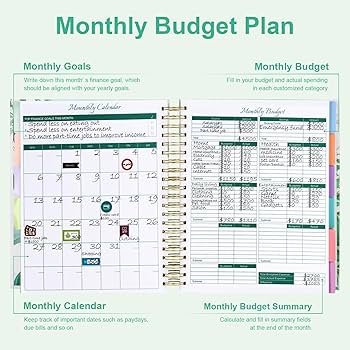Monthly & Yearly Budget Plans: Organize Your Finances for Success 📆

Effective financial planning requires both monthly and yearly budgeting. While monthly plans help track short-term spending and savings, yearly plans give a bigger picture of your financial health. This guide explains how to create, manage, and optimize monthly and yearly budgets to achieve financial goals in 2025.
Why Monthly & Yearly Budget Plans Are Essential 💵
- Track short-term expenses while preparing for long-term goals
- Identify seasonal spending patterns
- Ensure savings goals align with income
- Provide a roadmap for financial stability and growth 🌟
Step 1: Create a Monthly Budget Plan 📝
Steps:
- List monthly income sources 💰
- Categorize expenses: Fixed (rent, utilities), Variable (groceries, entertainment), Savings & Investments 🌱
- Set monthly savings goals and debt repayment targets
- Allocate funds for irregular expenses (insurance, subscriptions)
- Track spending weekly using apps or spreadsheets 📊
Tips:
- Use conditional formatting to highlight overspending 🔴
- Compare planned vs. actual expenses to stay on track
- Adjust categories as needed to meet goals
Step 2: Develop a Yearly Budget Plan 📆
Steps:
- Aggregate all monthly budgets to see annual totals
- Identify seasonal expenses: holidays, vacations, annual bills
- Plan for long-term goals: emergency fund, retirement, major purchases
- Allocate annual savings contributions across months
- Review and adjust quarterly to stay on track 🔄
Tips:
- Use charts to visualize yearly income vs. expenses
- Include a buffer for unexpected costs
- Track progress using both spreadsheet and visual dashboards
Monthly vs. Yearly Budgeting – Which to Focus On? ⚖️
| Aspect | Monthly Budget | Yearly Budget |
|---|---|---|
| Focus | Short-term spending & tracking | Long-term financial planning |
| Benefit | Quick adjustments & cash flow control | Big picture view & goal alignment |
| Tool | Spreadsheet, app | Annual planner, spreadsheet, calendar |
Best Approach: Use monthly budgets for day-to-day control and yearly budgets for strategic planning and goal alignment.
Tips to Maximize Budget Efficiency 💡
- Automate bill payments and savings transfers 🔄
- Review monthly and yearly budgets at the end of each month and year
- Combine digital tools and printable planners for better tracking
- Set SMART financial goals and adjust budget allocations accordingly
Common Mistakes to Avoid ❌
- Focusing only on monthly budgets without yearly planning
- Overlooking irregular or seasonal expenses
- Not updating or reviewing the budget regularly
- Failing to adjust savings and debt repayment targets
Conclusion ✅
Creating both monthly and yearly budget plans provides a complete view of your financial situation. By tracking short-term spending, planning for long-term goals, and reviewing progress regularly, you can maintain financial stability, save effectively, and achieve your dreams.




